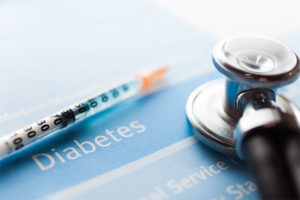4 Skin Conditions Caused by Diabetes

If you have diabetes, there are numerous signs and symptoms your body will exhibit. Some people are very thirsty, feel very tired, or have blurry vision. Very dry skin can also be a sign of diabetes, along with several other skin-related conditions. If you begin seeing these conditions, it may be time to see your doctor. Look out for these.
1. Acanthosis Nigricans (AN)
Darkening creases of one’s neck is often one of the first physical signs someone has diabetes. This condition is known as acanthosis nigricans. Those with darker skin tones experience these darkening, rough skin creases. Also affected are those who are obese or have a family history of acanthosis nigricans. The creases most commonly affected areas include:
- Neck
- Groin
- Armpits
- Knees
- Elbows
- Breasts
The changes to your skin appear over time and may sometimes be accompanied by an odor or itch. Acanthosis nigricans is often an indicator of insulin resistance which can lead to type 2 diabetes.
Diabetes is not the only cause of Acanthosis nigricans. It can also be associated with:
- Birth control pills
- Niacin
- Prednisone
- Ovarian cysts
- Adrenal issues
- Thyroid problems
Acanthosis nigricans can sometimes be a sign of certain internal cancerous tumors. There is no cure for the condition, although a dermatologist can treat the affected skin.
2. Diabetic Dermopathy
If you have pink, red, brown, scar-like lesions or spots on your lower legs, you may be suffering from diabetic dermopathy. This condition is also known as shin spots or pigmented pretibial patches.
These pigmented patches are thought to be caused by changes and leakage of the small blood vessels following some minor injury or trauma to the area. The spots are usually round and scaly. They may also appear as age spots.
While most commonly found in the lower legs, the condition can be anywhere on your body. The most common places include:
- Thighs
- Scalp
- Feet
- Chest
- Forearms
It is a relatively common condition, with approximately 50 percent of people with diabetes having some type of diabetic dermopathy. Diabetic dermopathy fades over time but can be minimized through good glucose management and the avoidance of injuries.
3. Eruptive Xanthomatosis
Sudden onsets of raised red pimple-like bumps that turn yellowish in color may be eruptive xanthomatosis. This is a rare condition caused by excessively high lipids or fat levels in your bloodstream.
When your insulin levels are low as a result of diabetes, your body has a hard time breaking down these lipids or fats in your bloodstream. These fats collect under your skin, causing these breakouts. In addition to diabetes, eruptive-xanthomatosis can also be caused by triglyceride-increasing medications.
These pimples can form anywhere on your body, but they are most commonly found in certain areas. These include:
- Bends of your elbows
- Bends of your knees
- Thighs
- Buttocks
Once they appear, they are itchy and tender to the touch. Eruptive xanthomatosis can be eradicated once your diabetes is under control or your triglycerideincreasing medications stopped.
4. Diabetic Foot Ulcers
Due to poor circulation and healing, approximately 15 percent of people with diabetes will develop diabetic foot ulcers. These open wounds or sores lead to 6 percent of those affected hospitalized for some type of infection or related complication.
While any person with diabetes can develop foot ulcers, they are more common in certain people. These include:
- People of color
- Older men
- Insulin-dependent diabetics
- Kidney, eye, and heart disease patients
- Obese patients
- Tobacco users
Ulcers can form from injury, poor circulation, and ill-fitting footwear. Unfortunately, neuropathy or the lack of feeling in your feet can allow the condition to occur and exist without your knowledge until it is too late to treat. It is estimated that 14 to 24 percent of diabetics who develop foot ulcers will experience some level of amputation.
If you experience any of these or other dermatological conditions, East Carolina Dermatology and Skin Surgery, PLLC, wants to help you regain great skin. Give us a call to schedule a consultation today.
